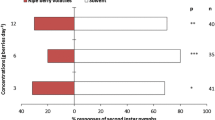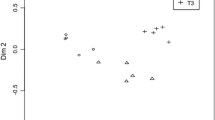Abstract
The coffee bean weevil (CBW), Araecerus fasciculatus (De Geer, 1775) (Coleoptera: Anthribidae) is an important pest of stored products such as grains, coffee beans, cassava, and traditional Chinese medicine materials. In China, CBW causes large losses of Daqu, a traditional Chinese liquor fermentation starter, and, unfortunately, the use of conventional insecticides against CBW is not suitable in Daqu storage. We found CBW to be highly attracted to fermenting yeast cultures, such as Kluyveromyces lactis. Eight volatile compounds, produced by fermenting cultures and not by sterile samples, were identified by gas chromatography coupled with mass spectrometry. Five of these substances elicited significant responses in Y-tube behavioral bioassays. Field trapping experiments revealed 2-phenylethanol and 2-phenylethyl acetate to be crucial for attraction of CBW. Results show that yeast volatiles play an important role in host location, and that 2-phenylethanol and 2-phenylethyl acetate could be utilized as potential attractants in monitoring and control systems against this important pest.




Similar content being viewed by others
References
Abdel-Gahny GM, Zalat SM, Abo-Ghalia AH, Semida FM (2008) Ecological studies of some insects associated with Bedouin settlements in St Katherine protectorate, South Sinai, Egypt. Egypt J Biol 10:95–103
Becher PG, Flick G, Rozpedowska E, Schmidt A, Hagman A, Lebreton S, Larsson MC, Hansson BS, Piskur J, Witzgall P, Bengtsson M (2012) Yeast, not fruit volatiles mediate Drosophila melanogaster attraction, oviposition and development. Funct Ecol 26:822–828
Begon M (1986) Yeasts and drosophila. In: Ashburner M, Carson H, Thompson JN (eds) The genetics and biology of Drosophila, vol 3b. Academic, London, pp 345–383
Boone CK, Six DL, Zheng Y, Raffa KF (2008) Parasitoids and dipteran predators exploit volatiles from microbial symbionts to locate bark beetles. Environ Entomol 37:150–161
Brand JM, Schultz J, Barras SJ, Edson LJ, Payne TL, Hedden RL (1977) Bark beetle pheromones: enhancement of Dendroctonus frontalis (Coleoptera: Scolytidae) aggregation pheromone by yeast metabolites in laboratory bioassays. J Chem Ecol 3:657–666
Cha DH, Adams T, Rogg H, Landolt PJ (2012) Identification and field evaluation of fermentation volatiles from wine and vinegar that mediate attraction of spotted wing drosophila, Drosophila suzukii. J Chem Ecol 38:1419–1431
Cheng KL, Huang F, Pan XX, Liu XY, Shen CH, Fan L, Yuan GH, Yang Y, Shen CP (2000) Relationship between the occurrence of Daqu pests and the period of Daqu production. Liq-Mak Sci Technol 100:32–33
Childers CC, Woodruff RE (1980) A bibliography of the coffee bean weevil Araecerus fasciculatus (Coleoptera: Anthribidae). Bull Entomol Soc Am 26:384–394
Cotterell GS (1952) The insects associated with export produce in southern Nigeria. B Entomol Res 43:145–152
Davis TS, Landolt PJ (2013) A survey of insect assemblages responding to volatiles from a ubiquitous fungus in an agricultural landscape. J Chem Ecol 39:860–868
Davis TS, Crippen TL, Hofstetter RW, Tomberlin JK (2013) Microbial volatile emissions as insect semiochemicals. J Chem Ecol 39:840–859
Dicke M (1988) Microbial allele chemicals affecting the behavior of insects, mites, nematodes, and protozoa in different tropic levels. In: Barbosa P, Letourneau DK (eds) Novel aspects of insect-plant interactions, p 125–163
Djordjević R, Gibson B, Sandell M, Billerbeck GM, Bugarski B, Vunduk J, Nikićević N, Nedović V (2015) Raspberry wine fermentation with suspended and immobilized yeast cells of two strains of Saccharomyces cerevisiae. Yeast 32:271–279
El-Sayed MT (1935) On the biology of Araecerus fasciculatus de Geer (Anthribidae), with special reference to the effects of variations in the nature and water content of the food. Ann Appl Biol 22:557–577
El-Sayed MT (1940) The morphology, anatomy and biology of Araecerus fasciculatus DeGeer (Coleoptera: Anthribidae). Bull Soc Fouad I Ent 24:82–126
El-Sayed AM, Heppelthwaite BJ, Manning LM, Gibb AR, Suckling DM (2005) Volatile constituents of fermented sugar baits and their attractiveness to lepidopteran species. J Agric Food Chem 53:953–958
Fabre CE, Blanc PJ, Goma G (1998) 2-phenylethyl alcohol: an aroma profile. Perfum Flavor 23:43–45
Fujii H, Kashio T, Ujiye T (1985) Records of coffee bean weevil, Araecerus fasciculatus DeGeer (Coleoptera: Anthribidae) feeding on citrus fruit in Japan. Proceedings of the Association for Plant Protection of Kyushu 31:202–203
Gethins L, Guneser O, Demirkol A, Rea MC, Stanton C, Ross RP, Yuceer Y, Morrissey JP (2015) Influence of carbon and nitrogen source on production of volatile fragrance and flavour metabolites by the yeast Kluyveromyces marxianus. Yeast 32:67–76
Gonda I, Bar E, Portnoy V, Lev S, Burger J, Schaffer AA, Tadmor Y, Gepstein S, Giovannoni JJ, Katzir N, Lewinsohn E (2010) Branched-chain and aromatic amino acid catabolism into aroma volatiles in Cucumis melo L. fruit. J Exp Bot 61:1111–1123
Grout TG, Begemann GJ, Stephen PR (2001) Monitoring and control of coffee bean weevil, Araecerus coffeae (Coleoptera: Anthribidae), in southern African citrus orchards. Afr Plant Prot 7:67
Hammons DL, Kurtural SK, Newman MC, Potter DA (2009) Invasive Japanese beetles facilitate aggregation and injury by a native scarab pest of ripening fruits. Proc Natl Acad Sci U S A 106:3686–3691
Hanssen HP, Sprecher E, Klingenberg A (1984) Accumulation of volatile flavour compounds in liquid cultures of Kluyveromyces lactis strains. Z Naturforsch C 39:1030–1033
Ikeura H, Murata N, Sakura A, Hayata Y, Kobayashi F (2012) Search for neem materials having repellent effect against green peach aphid (Myzus persicae Sulzer). Acta Hortic 989:97–102
Jang EB, Light DM, Binder RG, Flath RA, Carvalho LA (1994) Attraction of female Mediterranean fruit flies to the five major components of male-produced pheromone in a laboratory flight tunnel. J Chem Ecol 20:9–20
Jiang J (1993) Identification of flavour volatile compounds produced by Kluyveromyces lactis. Biotechnol Tech 7:863–866
Jiang J (1995) Volatile metabolites produced by Kluyveromyce lactis and their changes during fermentation. Process Biochem 30:635–640
King A, Richard DJ (2000) Biotransformation of monoterpene alcohols by Saccharomyces cerevisiae, Torulaspora delbrueckii and Kluyveromyces lactis. Yeast 16:499–506
Lam K, Tsang M, Labrie A, Gries R, Gries G (2010) Semiochemical mediated oviposition avoidance by female house flies, Musca domestica, on animal feces colonized with harmful fungi. J Chem Ecol 36:141–147
Martin V, Boido E, Giorello F, Mas A, Dellacassa E, Carrau F (2016) Effect of yeast assimilable nitrogen on the synthesis of phenolic aroma compounds by Hanseniaspora vineae strains. Yeast 33:323–328
Mphuru AN (1974) Araecerus fasciculatus DeGeer (Coleoptera: Anthribidae). A review. Trop Stored Prod Inf 26:7–15
Nout MJR, Bartelt RJ (1998) Attraction of a flying nitidulid (Carpophilus humeralis) to volatiles produced by yeasts grown on sweet corn and a corn-based medium. J Chem Ecol 24:1217–1239
Palanca L, Gaskett AC, Günther CS, Newcomb RD, Goddard MR (2013) Quantifying variation in the ability of yeasts to attract Drosophila melanogaster. PLoS One 8:e75332
Robacker DC, Bartelt RJ (1997) Chemicals attractive to Mexican fruit fly from Klebsiella pneumonia and Citrobacter freundii cultures sampled by solid-phase microextraction. J Chem Ecol 23:2897–2915
Schiestl FP (2010) The evolution of floral scent and insect chemical communication. Ecol Lett 13:643–656
Stensmyr MC, Dweck HKM, Farhan A, Ibba I, Strutz A, Mukunda L, Linz J, Grabe V, Steck K, Lavista-Llanos S, Wicher D, Sachse S, Knaden M, Becher PG, Seki Y, Hansson BS (2012) A conserved dedicated olfactory circuit for detecting harmful microbes in Drosophila. Cell 151:1345–1357
Tasin M, Betta E, Carlin S, Gasperi F, Mattivi F, Pertot I (2011) Volatiles that encode host-plant quality in the grapevine moth. Phytochemistry 72:1999–2005
Verhulst NO, Andriessen R, Groenhagen U, Bukovinszkiné-Kiss G, Schulz S, Takken W, van Loon JJA, Schraa G, Smallegange RC (2010a) Differential attraction of malaria mosquitoes to volatile blends produced by human skin bacteria. PLoS One 5:e15829
Verhulst NO, Takken W, Dicke M, Schraa G, Smallegange RC (2010b) Chemical ecology of interactions between human skin microbiota and mosquitoes. FEMS Microbiol Ecol 74:1–9
Wang YH, Zhang HB, Yang HM, Meng QQ, Wang FH (2013) The fermentation advantage of Kluyveromyces lactis and its application in the field of food enzyme. Chin Biotechnol 33:121–126
Wu YK, Chen BT, Ou GT (2011) Damage of coffee bean weevil (Araecerus fasciculatus DeGeer) on its new host Jatropha curcas L. Plant Dis & Pest 2:22–24
Yan XP, Song YC, Shen ZP, Li WW, Pu W, Zhou H (2006) An updated list of stored grain insects in China in 2005. Grain Storage 35:3–9
Zheng XW, Tabrizi MR, Nout MJ, Han BZ (2011) Daqu - a traditional Chinese liquor fermentation starter. J I Brewing 117:82–90
Acknowledgements
This work was funded by State Key Laboratory for Biology of Plant Diseases and Insect Pests (SKLOF201609), Doctoral Program of Hebei Academy of Agricultural and Forestry Sciences (4940701YBNE4N5), the National Basic Research Program of China (2012CB114104) and the NSFC (31321004). We thank Prof. David Hall (Natural Resources Institute, University of Greenwich, UK) for assistance in preparation of the manuscript.
Author information
Authors and Affiliations
Corresponding authors
Additional information
Shuai Yang and Xiangdong Mei have contributed equally to this work.
Electronic supplementary material
ESM 1
(DOCX 308 kb)
Rights and permissions
About this article
Cite this article
Yang, S., Mei, XD., Zhang, XF. et al. Attraction of Coffee Bean Weevil, Araecerus fasciculatus, to Volatiles from the Industrial Yeast Kluyveromyces lactis . J Chem Ecol 43, 180–187 (2017). https://doi.org/10.1007/s10886-016-0809-5
Received:
Revised:
Accepted:
Published:
Issue Date:
DOI: https://doi.org/10.1007/s10886-016-0809-5




